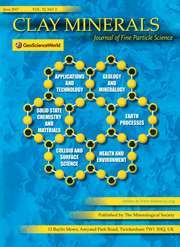Article contents
Unidimensional fourier synthesis of vermiculite
Published online by Cambridge University Press: 14 March 2018
Extract
The structures of vermiculite and montmorillonite are very similar in that they consist of talc-like or pyrophyllite-like layers interleaved with layers of water molecules, the latter carrying exchangeable cations. In vermiculite, the exchange positions are normally filled by Mg ions, and the water layers consist of double sheets of water molecules with the exchangeable Mg ions presumably centrally placed. The water layers in natural Mg-saturated vermiculite are 5.1 Å high and it seems probable that this distance is fixed by the size of the hydration shells surrounding the exchangeable Mg ions as one of us (G.F.W.) has previously suggested.
Although vermiculite is found in particles of clay size, it also occurs as large flakes produced by the hydrothermal alteration of mica. This seemed a good reason for making a Fourier curve of the mineral in the c-direction with the object of examining the organization of the water layers. It was hoped that greater detail might be obtained from single crystals of vermiculite than would be possible in the case of montmorillonite, where oriented aggregates consisting of large numbers of very small crystals must of necessity be used.
- Type
- Research Article
- Information
- Copyright
- Copyright © The Mineralogical Society of Great Britain and Ireland 1951
References
- 2
- Cited by


